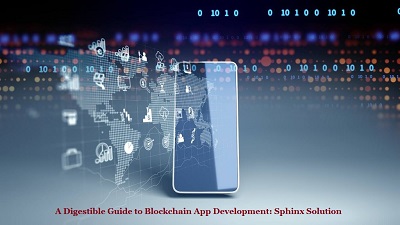A DIGESTIBLE GUIDE TO BLOCKCHAIN APP DEVELOPMENT

The importance of Blockchain, through the lens of data:
- The global blockchain market will reach $1,431.54 billion by 2030.
- 20% of IoT technologies use blockchain-enabled services.
- On-Line PLC, a UK-based organization, witnessed a share price surge by 394% just by changing the company name to On-Line Blockchain PLC.
We know what you’re thinking, “Let’s delve into blockchain mobile app development.” However, read this article before you do.
In the next five minutes, this blockchain app development guide will discuss the definition, types, development platforms, and factors to keep in mind about blockchain app development.
A blockchain app development guide
What is Blockchain?
Blockchain is a publicly accessible database where digital information or transactional record are encrypted and stored in blocks and paired to each other with a hash function. Each block has the hash code of the previous entry.
Furthermore, from a business perspective, blockchain is an exchange network that transfers value from peer to peer. The mechanism authorizes a transaction and validates the same from the legal perspective without middlemen.
Blockchain types
- Network
Network-based blockchain has two subtypes — Permissionless Blockchain and Permissioned Blockchain.
Permissionless: The whole network remains publicly accessible on computers and mobile devices. Thus, anyone can:
- Access the code
- Run a public node on local devices
- Initiate interactions in the network
- Verify the transaction
Furthermore, the user can remain anonymous all the while.
Bitcoin is an example of a Permissionless blockchain.
Permisssioned: A closed ecosystem which allows only the authorized participants to act on the blockchain development roadmap as per the user’s specific role.
A set of predefined rules determine how each transaction will be implemented to fulfil the needs of blockchain development companies.
Multichain will be an example of a Permissioned blockchain.
2. Cryptocurrency support
Cryptocurrency-based blockchain is further categorized into 4 sub-categories:
Crypto Exchange: Blockchain systems for trading cryptocurrencies or digital currencies. You can pay using a credit card or postal money orders, among other payment methods.
Wallets: Holds the private or public keys for sending, receiving, or storing cryptocurrencies. Also known as a crypto wallet.
Dapp: A decentralized app (dApp) development service dealing with apps not controlled by a single authority. The solution runs on a decentralized P2P network in real-time. Golem, Sia, and Augur are some of the examples.
ICO: Initial Coin Offerings (ICO) or Initial Currency Offering (ICO) is a crowdfunding system dealing with the generation and selling of cryptocurrencies or crypto tokens.
Blockchain App Development: Sphinx Solution
Blockchain app development platforms
Over 25 platforms build blockchain solutions. We’ll discuss the top 5 platforms among them below:
- EOS
The platform offers decentralized application hosting, smart contract capability, and decentralized storage of enterprise solutions.
The features solve scalability issues and eliminate the fees borne by the user.
2. Multichain
Creates and deploys private blockchain solutions for use between and within multiple companies.
3.Ethereum
An open-source public platform and operating system that helps in ICOs and blockchain dApp development with smart contract functions.
The platform is adaptable; thereby making it a favorite for blockchain app development companies for developing a blockchain app.
4.Hyperledger
An open-source platform that creates advanced blockchain software development solutions.
Examples include creating blockchain apps for supply chain management and developing blockchain solutions for IoT.
5. IOTA
An open-source DLT-based solution that offers secure and fast payment services between connected IoT devices.
The platform uses Directed Acrylic Graph (DAG) technology to offer characteristics including faster confirmation times, free transactions irrespective of the transaction size, and unlimited transaction handling at the same time.
Factors to consider for blockchain mobile app development
- Choose whether you need a smart contract.
- Finalize the consensus protocol such as Proof of Elapsed Time, Proof of Work, and Proof of Burn.
- Choose between public and private networks.
- Check the Adoption Rate and community support level of the blockchain.
Blockchain app development guide — the technology is here to stay
The global blockchain market will generate $20 billion in revenue by 2024. Thus, having a strong grasp of the technology is essential.
We hope this blockchain app development guide has offered you a framework upon which you can build your app.
Articles from Shivraj Dhaygude
View blogRobotic Process Automation (RPA) is ideal for all businesses – small, medium, and large. If you want ...
How much does it cost to develop a mobile app like Zomato in India? You ask. · Depending on whom you ...
You may be interested in these jobs
-
Senior Frontend Developer
Found in: Talent IN 2A C2 - 5 days ago
Avataar Bengaluru, IndiaAt Avataar, we are re-imagining product discovery for shopping/commerce with the power of spatial depth. We are taking the latest advances in Neural Rendering, Computer Graphics, Generative models and the web to empower the next generation of visual storytelling. We recently anno ...
-
Senior Operations Specialist
Found in: Appcast Linkedin IN C2 - 2 days ago
Rightpoint India Jaipur, IndiaThe Operations support specialist will be responsible for the day-to-day operations management for Talent Solutions Group business unit at Rightpoint for a global team. · Description · Rightpoint, a Genpact company (NYSE: G) is a global experience leader. Over 12 offices work wi ...
-
Lead Java Developer
Found in: Appcast Linkedin IN C2 - 2 days ago
157 Careers Pune, Indiaurgently required java full stack developers for pune location: · skills: java , spring boot, rest api, micro services, angular or reactjs · location: Pune · mode: Work from office · if interested, please share your resume on or call me on · responsibilities: · Strong hands-on ...



Comments